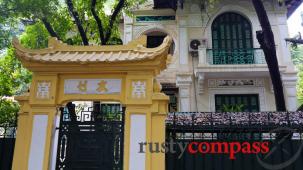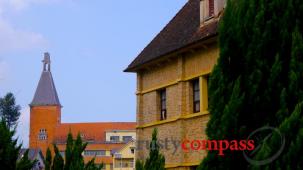Phnom Penh’s sprawling Royal Palace is the symbol and focal point of the city. It has been the residence of Cambodian Kings since its construction in 1866. Most of the original timber buildings have disappeared and the most imposing surviving structures in the complex date from the early twentieth century.
The Royal Palace borrows heavily from its counterpart in Bangkok. Remarkably, it survived the ravages of the Pol Pot Khmer Rouge era. Its longest resident, King Norodom Sihanouk was one of the great political survivors of the twentieth century. He was an important political operative even longer than Fidel Castro though his career was infinitely more tumultuous. Sihanouk was active in Cambodian politics - including two stints as King - from the 1940s until his abdication in 2004.
Sihanouk and Mao
Sihanouk was a player large and small in all of Cambodia’s troubled post WWII history from the achievment of independence from France in 1953, the early years of independence, the impossible diplomatic challenges of the Vietnam War’s spillover into Cambodia, as well as the collapse of the country and the rise of the Khmer Rouge.
Sihanouk images in the Royal Palace Museum.
Most recently he was instrumental in the creation of the somewhat democratic state that followed UN intervention and elections in the 1990s. He has enjoyed the devotion of the country’s population throughout. In many ways Sihanouk, like Cambodia, has been a victim of the regional aspirations of other powers - especially the United States and China as well as neighbours Vietnam and Thailand.
The Throne Hall. The current monarch, King Norodom Sihamoni was coronated here in 2004.
This patch of Europe amidst the stupas and spires was originally erected in Egypt to mark the inauguration of the Suez canal 1869. Less than ten years later, the entire structure was shipped to Cambodia and presented to King Norodom by French Emperor Napoleon III.
The Silver Pagoda, also known as the Pagoda of the Emerald Buddha is perhaps the most cherished of the structures in the Palace complex. The interior features thousands of silver tiles, some of which are on display and a collection of other national treasures.
- The Silver Pagoda
The outer wall of the Silver Pagoda features a fading beautiful fresco depicting the Khmer version of the Indian epic The Ramayana dating from the beginning of the twentieth century.
Fresco, Silver Pagoda.























